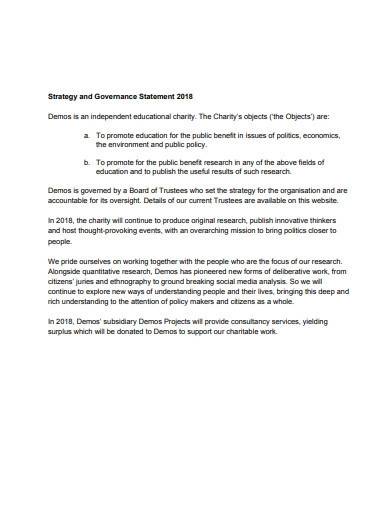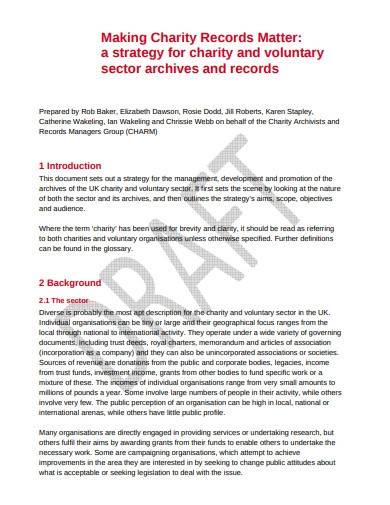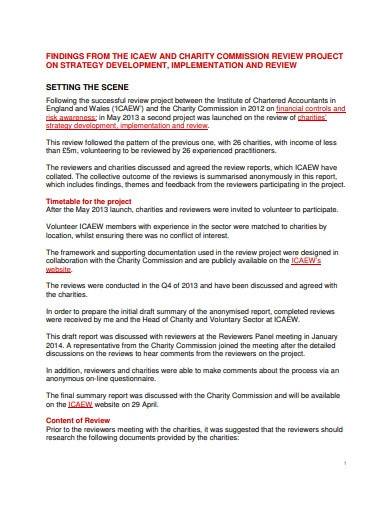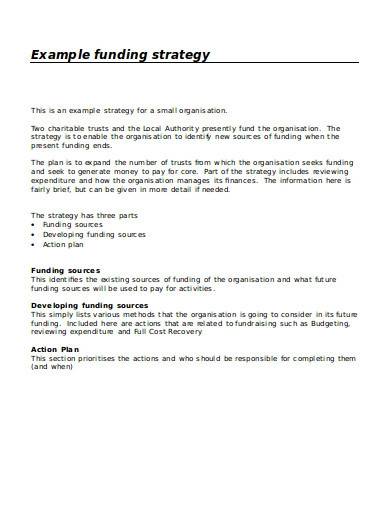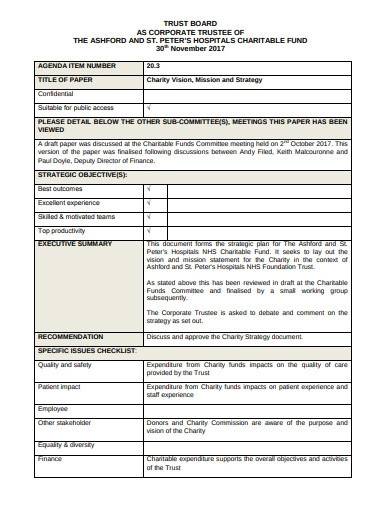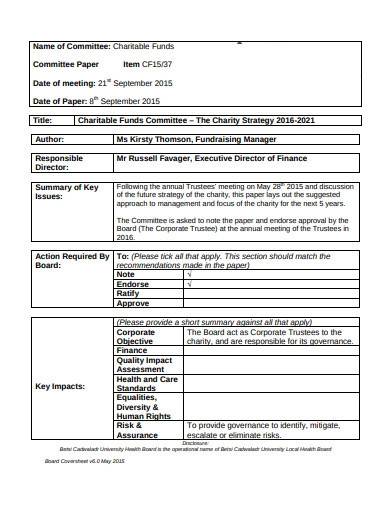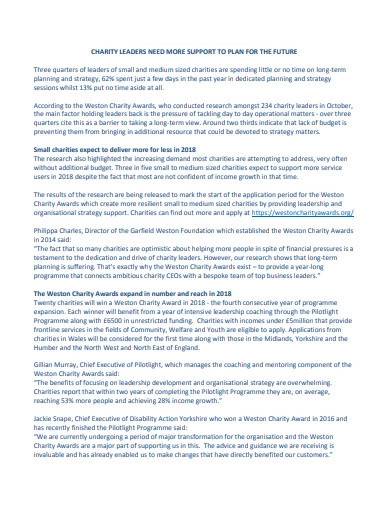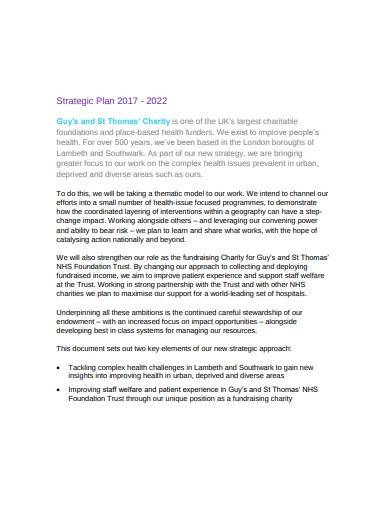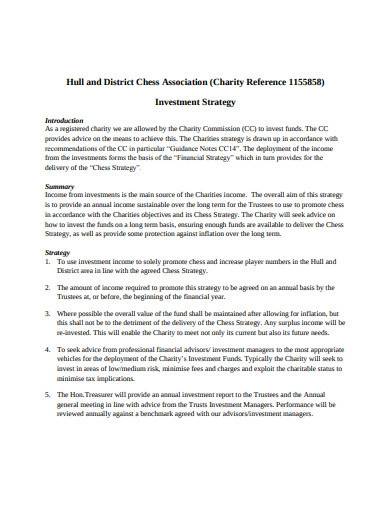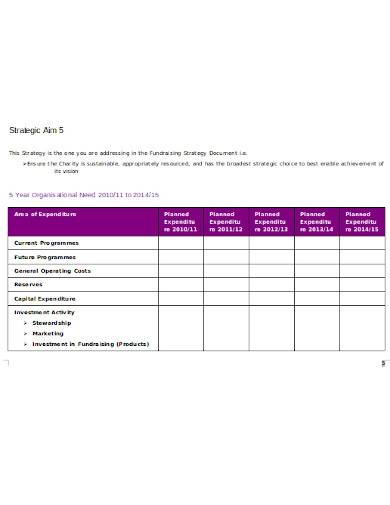First and foremost, charity strategy is essential for ensuring that charitable efforts are focused and impactful. Without a clear strategy implementation, it can be challenging to determine how best to use time resources management, money tracker, and personnel. A well-designed charity strategy can help an organization or individual identify the most pressing needs in the community or cause they are supporting, assess the most effective interventions, and develop planner samples for how to allocate resources in a way that maximizes impact.
FREE 10+ Charity Strategy Samples & Templates in MS Word | PDF
1. Charity Strategy Template
2. Charity Strategy Plan Template
3. Sample Charity Strategy Template
4. Charity Funding Strategy Plan Template
5. Trust Charity Strategy Plan Template
6. Charity Strategy Sample
7. Small Charity Strategy Plan Template
8. Simple Charity Strategy Plan Template
9. Charity Investment Strategy Plan Template
10. Charitable Investment Strategy Template
11. Charity Fundraising Strategy Plan
What is Strategy Charity?
Charity strategy refers to a plan or approach that an organization or individual uses to guide their charitable activities. A charity strategy typically involves identifying the fundraising goal tracker and objectives of the charity, assessing the needs of the community or cause being supported, and developing a strategic planning for how to best allocate resources to achieve those goals.
How To Make Strategy Charity?
Effective charity strategies often involve careful consideration of factors such as the target beneficiaries, the most effective interventions, the resources required, and the potential impact of the charity’s activities. Additionally, charity strategies may involve joint partnership venture proposal with other organizations, fundraising and charity marketing strategy initiatives, and ongoing evaluation and assessment of the effectiveness of the charity’s efforts. Making a charity strategy involves several steps that can help an organization or individual to define their goals, identify the needs of the community or cause they wish to support, and develop a plan for how to allocate resources effectively. The following are steps that can be taken to develop a charity strategy:
Step 1- Define Goals
The first step in developing a charity strategy is to define the SMART goals statement of the charity. These goals should be specific, measurable, achievable, relevant, and time-bound (SMART). For example, if the goal is to improve education outcomes in a particular community, the objective should be clear, such as increasing the number of students graduating from high school by 20% within three years.
Step 2- Identify Target Beneficiaries
The next step is to identify the target beneficiaries of the charity’s efforts. This involves identifying the individuals or communities that will benefit from the charity’s activities. It is important to consider the unique needs and circumstances of these beneficiaries to ensure that the charity’s efforts are effective.
Step 3- Assess the Needs
Once the target beneficiaries have been identified, the next step is to assess their needs. This involves conducting research, engaging with stakeholders, and data tracking to better understand the challenges faced by those who will benefit from the charity’s efforts. Based on the goals and needs assessments, develop a plan that outlines the activities, resources, and timelines required to achieve the goals of the charity. This plan should be guided by evidence-based interventions that have been shown to be effective in similar contexts.
Step 4- Allocate Resources
Once the plan is developed, the next step is to allocate resources effectively. This involves identifying the financial, personnel, and other resources required to implement the charity’s activities. It is important to prioritize resources based on their potential impact, considering both short-term and long-term goals.
What are the key elements of a successful charity strategy?
The key elements of a successful charity strategy include a clear understanding of the target beneficiaries, evidence-based interventions, resource requirements, and ongoing evaluation and assessment. Effective charity strategies must balance the need to allocate resources efficiently with the need to achieve meaningful impact.
How do you make a charity strategy?
To make a charity strategy, you should define the goals, identify the target beneficiaries, assess the needs, develop a plan, allocate resources, and implement and monitor progress. A successful charity strategy must be based on evidence-based interventions and should be regularly evaluated and adjusted as necessary.
Can a charity strategy be changed?
Yes, a charity strategy can be changed. As the needs of the community or cause evolve, it may be necessary to adjust the goals, interventions, and resource allocation of the charity strategy. Regular evaluation and assessment of the strategy can help identify areas for improvement and opportunities for change.
In conclusion, charity strategy is a critical component of effective philanthropy. A well-designed charity strategy can help maximize the impact of charitable efforts, enabling organizations and individuals to make a positive difference in the lives of those they serve. To be successful, charity strategies must be informed by a clear understanding of the target beneficiaries, evidence-based interventions, resource requirements, and ongoing evaluation and assessment. By following these key principles, charities can achieve meaningful impact and create lasting change in their communities and causes.
Related Posts
FREE 10+ Charity Privacy Policy Samples & Templates in MS Word | PDF
FREE 10+ Charity Standing Order Form Samples & Templates in MS Word | PDF | MS Excel
FREE 10+ Charity Risk Management Policy Samples & Templates in PDF
FREE 3+ Charity Investment Strategy Samples & Templates in PDF | MS Word
FREE 5+ Charity Marketing Policy Samples & Templates in PDF
FREE 5+ Charity Recruitment Policy Samples & Templates in MS Word | PDF
FREE 3+ Charity Management Accounts Samples & Templates in PDF
FREE 10+ Charity Gift Aid Form Samples & Templates in MS Word | PDF
FREE 6+ Charity Marketing Strategy Samples & Templates in MS Word | PDF
FREE 10+ Charity Financial Policy Samples & Templates in MS Word | PDF
FREE 10+ Charity Financial Policies and Procedures Samples & Templates in MS Word | PDF
FREE 10+ Charity Expenses Policy Samples & Templates in MS Word | PDF
FREE 10+ Charity Donation Letter Samples & Templates in MS Word | PDF
FREE 4+ Charity Request Letter Samples & Templates in MS Word | PDF
FREE 5+ Charity Impact Report Samples in PDF

